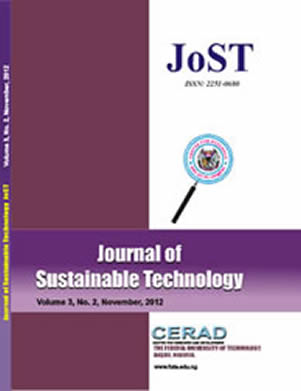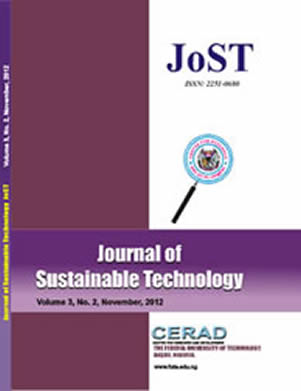Plectranthus esculentus (Lamiaceae) tubers was evaluated for its nutritional content
and potential utilization. A white starch produced from the tubers was characterized using Fourier
Transform Infrared (FTIR), Scanning Electron Microscopy (SEM), Energy dispersive X-ray (EDX)
and Nuclear Magnetic Resonance (NMR) spectroscopy and was utilized as an excipient in
pharmaceutical formulations. Elemental analysis of the tubers revealed the content of Calcium
(78.0mg/100g), Magnesium (92.5mg/100g), Sodium (31.4mg/100g), Potassium (129.2mg/100g),
Manganese (5.67mg/100g), Copper (0.4mg/100g), Iron(2.65mg/100g) and Zinc(1.3mg/100g)
respectively. The result also showed that the tubers had moisture (5.25%), ash (4.45%), crude
protein (14.4%), crude fat (1.2%), crude fibre (1.6%) and carbohydrate (81.4%) respectively.
Application of FTIR and ID-NMR spectroscopy to the starch from P.esculentus tubers in combination
with chemical data, led to confirm that the structure of the original polysaccharide contains α-Dglucose
linked at 1 ’! 4. The starch granules possessed better flow properties with hausner ratio of
0.9 to 1.24 and carr’s index of 7.5 to 20%. Tablet prepared with 4-8%w/w starch had hardness
5kg while tablets prepared with 6-8%w/w binders had friability of less than 1% comparable to
that prepared with 4% w/w corn starch and cassava starch. The disinstegration time of the tablets
was less than 15minutes. The tablets had fast dissolution in 45 minutes. This makes the tubers and
starch of P.esculentus potential candidate as additive and excipient in food and pharmaceutical
formulations.
Keywords: Plectranthus esculentus; polysaccharide; ID-NMR; Proximate; excipient
PAPER TITLE :CHARACTERIZATION, NUTRITIONAL EVALUATION AND POTENTIAL UTILIZATION OF INDIGENOUS LIVINGSTONE POTATO (PLECTRANTHUS ESCULENTUS)
JOURNAL Of SUSTAINABLE TECHNOLOGY | VOLUME 8 NUMBER 2 2017
Paper Details
- Author(s) : ADEYANJU, O.; PLAVEC, J.; EGGA, E.S. and EWAOCHE, E.A.
- Abstract:



